Taking Antibiotics Safely
Make sure to ask your medical provider or pharmacist how to take antibiotics safely, and always take them exactly as directed. Before taking an antibiotic, tell your medical provider about all medications you take and any allergies. Ask about drug side effects. Take antibiotics for the prescribed amount of time, even after you feel better.
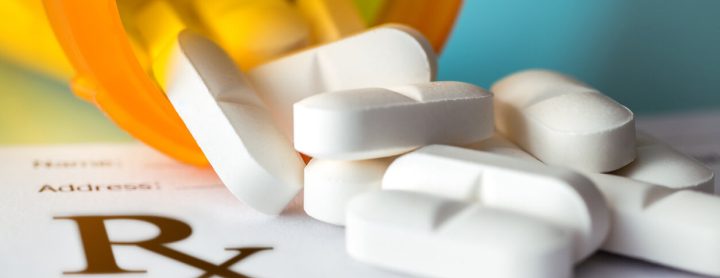
Antibiotics are medications that treat bacterial infections. Penicillin was the first antibiotic widely available in the 1940s. Since then, researchers have developed several others.
These medicines come in capsules, chewable tablets, powders for liquid suspension, intravenous formulations, creams and ointments. Most are available only by prescription, though some topical creams and ointments may be available over-the-counter.
Antibiotics can treat bacterial infections of the ear, nose, throat, genitourinary tract and respiratory system. Each type of antibiotic may be more or less effective for certain strains of bacteria, so a medical provider will choose the antibiotic that will work best for the specific infection.
- Strep throat
- Sinus infections
- Ear infections
- Urinary tract infections
- Traveler’s diarrhea
- Skin infections
- Pneumonia
- Pink eye (bacterial conjunctivitis)
Antibiotics don’t work against infections caused by fungi such as yeast infections and athlete’s foot or viruses such as the flu and the common cold.
Using antibiotics incorrectly can lead to a relapse of illness or antibiotic resistance. Certain antibiotics can’t kill bacteria that have antibiotic resistance, and this can make it harder to treat serious infections.
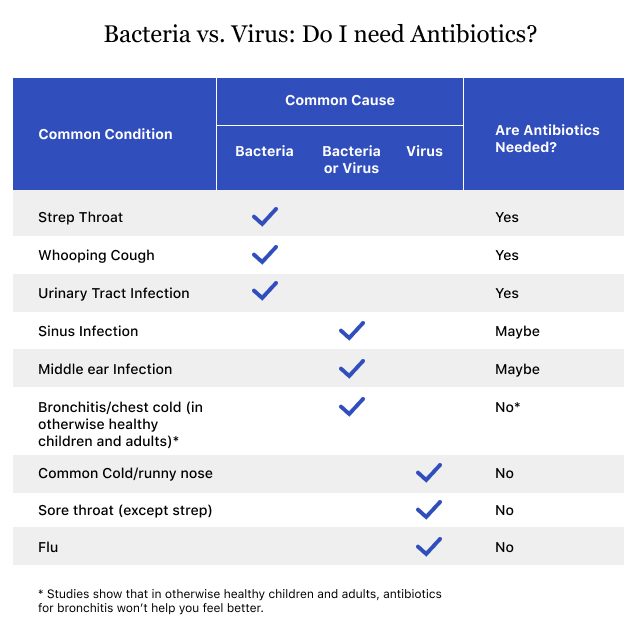

How Do They Work?
Generally, antibiotics work to treat bacteria in two ways. Antibiotics called bactericidal agents cause bacterial cell death. Others called bacteriostatic agents stop bacteria growth and reproduction.
For example, bactericidal antibiotics like penicillin and amoxicillin cause breakdown in bacterial cell walls. This leads to cell death. Antibiotics like erythromycin and clarithromycin primarily prevent bacteria from synthesizing protein, stopping their growth.
Antibiotics start working right away after a person takes them. Each antibiotic may stay in the body for different lengths of time, but common antibiotics such as amoxicillin and ciprofloxacin stay in your system for about 24 hours after taking the last dose. It might take longer for people with impaired kidney function to eliminate the drug from the body.
Some antibiotics will take days to leave the body. Azithromycin stays in the body for about 15 days after the last dose.
Ask your pharmacist or medical provider for specific information on how long the antibiotic you are taking stays in the body.

Common Types
There several classes of antibiotics available in the United States. These drugs are grouped together by their chemical structure. Each antibiotic class has similarities and differences in how effective they are at treating certain types of bacteria.
| Class | Examples | How They Work |
|---|---|---|
| Beta-Lactams (sub classes: penicillins, carbapenems, cephalosporins, monobactams) | Penicillin, Amoxil (amoxicillin), Keflex (cephalexin), Premaxin (imipenem), Omnicef (cefdinir) | Kill bacteria by preventing formation of the bacterial cell wall |
| Fluoroquinolones, or Quinolones | Cipro (ciprofloxacin), Levaquin (levofloxacin), Avelox (moxifloxacin) | Kill bacteria by preventing bacteria from making DNA |
| Macrolides | Zithromax, Z-Pak (azithromycin), Erythrocin (erythromycin) | Prevent bacteria from multiplying by preventing them from making proteins |
| Tetracyclines | Sumycin (tetracycline), Adoxa and Adoxa-Pak (doxycycline) | Prevent bacteria from multiplying by preventing them from making proteins |
| Glycopeptides | Vancocin (vancomycin), Dalvance (dalbavancin), Orbactiv (oritavancin) | Kill bacteria by preventing formation of the bacterial cell wall |
| Polypeptides | Baciim (bacitracin), polymyxin B | Kill bacteria by preventing formation of the bacterial cell wall |
| Sulfonamides | Sulfamylon (mafenide), sulfadiazine | Prevent bacteria from multiplying by preventing them from making proteins |
| Oxazolidinones | Zyvox (linezolid), Sivextro (tedizolid) | Prevent bacteria from multiplying by preventing them from making proteins |
| Nitroimidazoles | Flagyl (metronidazole), Tindamax (tinidazole) | Kills bacteria by disrupting production of genetic material |

How to Take Antibiotics
Always take antibiotics for the length of time that they are prescribed, even if symptoms have subsided. Make sure to read the drug label carefully before taking the medication and ask your medical provider or pharmacist about any side effects or precautions you should take.
It’s important to make sure you take your antibiotics at regularly scheduled doses — for example, every 8 hours or every 12 hours. This is so the medicine’s effect spreads out evenly over the course of a day. Make sure to ask your medical provider if you should take your medication with food or on an empty stomach.
If you miss a dose, take it as soon as you remember. But if it’s closer to your next scheduled dose, skip it and take your next dose at the regular scheduled time. Never take two doses at once to make up for a skipped dose.
- Talk to your medical provider if you have questions about your medicine.
- Don’t share your antibiotics with others.
- Don‘t save extra antibiotics for later. Take your medication for the length of time prescribed by your medical provider.
- Never flush expired antibiotics and ask your pharmacist for the best way to dispose of old medicines.
- Don’t take someone else’s antibiotics because you feel sick. This could make you sicker or cause side effects.
Can you drink alcohol while taking antibiotics?
In general, it’s safe to drink alcohol in moderation with most antibiotics. But three antibiotics — metronidazole, tinidazole and trimethoprim-sulfamethoxazole — can lead to serious reactions with alcohol, according to the UK’s National Health Service and the University of Pittsburgh Medical Center.
- Nausea
- Headache
- Dizziness
- Irregular or fast heartbeat
- Flushing
- Abdominal and chest discomfort
- Vomiting
The safety of drinking alcohol while taking specific antibiotics may be different for different people. Therefore, you should always check with your doctor or pharmacist before drinking alcohol while taking an antibiotic.
Can you eat dairy while taking antibiotics?
Eating dairy products such as butter, cheese, milk and yogurt can interfere with how some antibiotics work. You may have to wait up to three hours after taking an antibiotic to consume dairy products.
Do antibiotics affect birth control?
Some antibiotics may increase the breakdown of estrogen, decreasing the effectiveness of birth control. But according to Planned Parenthood, the only antibiotic that could make birth control less effective is rifampin, known under the brand names Rifadin and Rimactane.
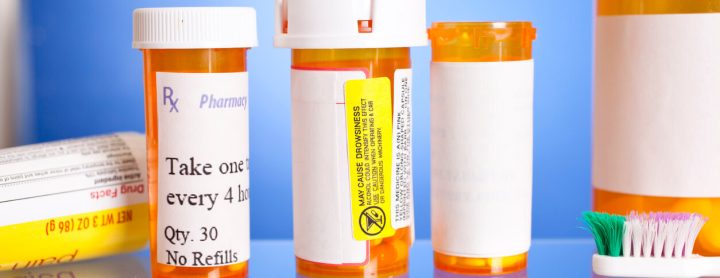
Storing Medicine Properly
In general, you should store antibiotics in a cool, dry place. But it’s important to follow instructions on the drug label and any instructions given by a medical provider or pharmacist regarding your specific antibiotic. For example, some medicines may need to be refrigerated.
Each package of medicine will have an expiration date printed on it. Don’t take antibiotics past the expiration date. Expired antibiotics may fail to properly treat infections and lead to antibiotic resistance, according to the FDA.
Tests on drug stability from the mid-1980s to early 1990s found that liquid antibiotics showed signs of physical decay after expiration, according to an article published by Harvard.

Side Effects of Antibiotics
Antibiotics save lives, but nearly one out of five ER visits each year is linked to antibiotic side effects. These side effects are also the most common cause of ER visits for children younger than 18 years of age.
Because these are powerful drugs, people should be mindful of misusing them. Most common side effects are mild. If they get worse or don’t go away, talk to your medical provider.
- Diarrhea
- Stomachache
- Nausea
- Yeast infections
- Headache
Some side effects can be serious. These include allergic reactions and an infection caused by Clostridium difficile.
Allergic Reactions
Before you take antibiotics, tell your medical provider if you’ve had a history of allergic reactions to penicillin or other antibiotics.
- Swollen face, lips, mouth or tongue
- Difficulty breathing
- Skin rash or hives
- Difficulty swallowing or breathing
- Itching
- Skin peeling or blisters
- Wheezing
Clostridium Difficile
Antibiotics alter the helpful bacteria in your gut and can lead to an overgrowth of a bacterium called Clostridium difficile, or C. diff, which can cause severe diarrhea and potentially fatal colitis (inflammation of the colon). Tell a medical provider if you develop severe diarrhea, fever, cramping, stomach pain or bloody stool after using antibiotics.
Taking Probiotics with Antibiotics May Help with Side Effects
In the case of diarrhea, abdominal cramping or gas, some research suggests taking a probiotic with your antibiotic may help lessen side effects, according to the Cleveland Clinic. Probiotics also include fermented foods like sauerkraut or yogurt.
Probiotics can also help with diarrhea from C. diff. In fact, one analysis published in the journal Infection Control and Hospital Epidemiology by Bradley Johnston and colleagues found a reduction of up to 65 percent in C difficile-associated diarrhea in patients taking probiotics with their antibiotics. This benefit may be greater in patients who have a higher risk of developing diarrhea from C. diff. Talk to your doctor to help determine if you are at a higher than usual risk.
The most commonly used probiotics for antibiotic-associated diarrhea are Lactobacillus rhamnosus-based and Saccharomyces boulardii-based probiotics. Before taking any probiotics, make sure you ask your medical provider or pharmacist if they are safe for you.
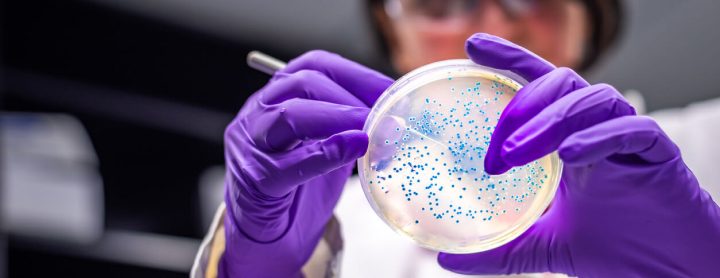
Antibiotic Resistance
Antibiotic resistance occurs when bacteria develop ways to protect themselves against antibiotics.
“If you keep using the same antibiotics routinely, the bugs basically mutate, and they can live through antibiotic treatment,” immunologist and thoracic surgeon Dr. Hooman Noorchashm told Drugwatch.
This means fewer drugs can kill them, and these infections may become more dangerous. Someone who is infected with bacteria that is resistant to antibiotics will usually need to stay in the hospital longer and doctors will have to use treatments that are more expensive and have more side effects. Antibiotic-resistant bacteria cause more than 2.8 million infections annually, and more than 35,000 Americans die each year because of them, according to the Centers for Disease Control and Prevention.
Antibiotic resistance is one of the most urgent threats to public health. It is connected to the health of people, animals and the environment.
- Penicillin, released in 1941
- Staphylococcus aureus (staph infection), Streptococcus pneumoniae (pneumonia, ear infections, sinus infections and meningitis), Neisseria gonorrhoeae (gonorrhea)
- Vancomycin, released in 1958
- Enterococcus faecium (endocarditis, prostatitis, urinary tract infections, intra-abdominal infection, wound infection and cellulitis), Staphylococcus aureus (staph infection)
- Ciprofloxacin, released in 1987
- Neisseria gonorrhoeae (gonorrhea)
- Ceftazidime-avibactam, released in 2015
- Ceftazidime-avibactam-resistant KPC-producing Klebsiella pneumoniae (pneumonia, wound or surgical site infections, bloodstream infections and meningitis)
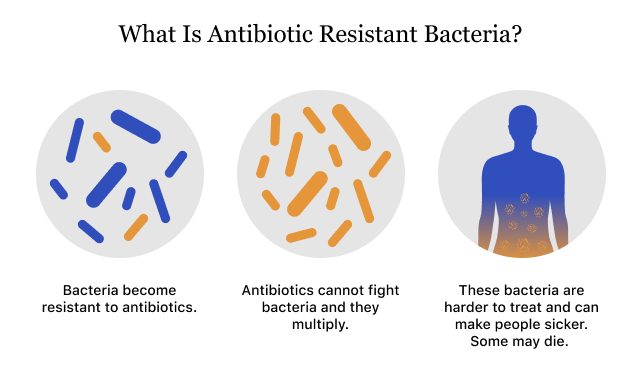
Antibiotic resistance can occur anytime antibiotics are used. That’s why it’s important not to use antibiotics if you don’t need them. If your doctor determines that you do not have an infection that needs antibiotics, you should not insist that you receive an antibiotic. Too many antibiotics are being misused and prescribed when they are not needed. The CDC estimates that about 47 million antibiotics are prescribed for infections, like the cold and flu, that do not need these drugs.
Another way you can help prevent the threat of antibiotic resistance is to make sure you take antibiotics as directed for the full length of treatment to kill all organisms. You should not save antibiotics for use at a later time and you should never share antibiotics with someone else.

Takeaways for Using Antibiotics Safely
Dr. Hooman Noorchashm prescribed antibiotics to his patients for years. These are some quick, basic tips that he gave his patients for taking antibiotics safely.
- Get a Specific Diagnosis
- “You want to make sure that there’s a specific bug that you are afflicted by and have a diagnosis for, like strep throat for example,” Noorchasm said. “You don’t want to take antibiotics just because you feel sick.”
- Don’t Take Antibiotics to Prevent Sickness
- “You don’t want to take antibiotics prophylactically (to prevent illness) unless your medical provider has given you a clear indication,” said Noorchashm. “For example, some patients with heart valves who are going to have a dental procedure have to take antibiotics to prevent infections.”
- Communicate Allergies
- “Tell your medical provider about any known allergies to penicillin (or other antibiotics) to make sure they don’t give you that class of antibiotics,” said Noorchashm.
- Ask About Side Effects
- “All of these drugs at a certain rate will cause adverse events, anywhere from colitis from C. diff to nerve damage and hearing loss,” Noorchashm said. “This is why you don’t want to use them unless you are treating a real bacterial infection.”
Calling this number connects you with a Drugwatch.com representative. We will direct you to one of our trusted legal partners for a free case review.
Drugwatch.com's trusted legal partners support the organization's mission to keep people safe from dangerous drugs and medical devices. For more information, visit our partners page.

